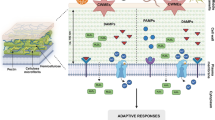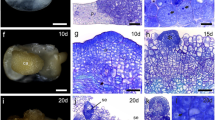Abstract
Corolla tube formation inTrachelospermum asiaticum, Nerium indicum var.leucanthum, Anodendrom affine, Vinca major, Catharanthus roseus andAmsonia elliptica was investigated anatomically.
The corolla tube formation among these species is basically similar. The bases of petal primordia extend laterally to the interprimordial regions, the upward growth occurrig at those regions just beside the petal bases. The extending petal bases connect with each other at the bases of the abaxial side of stamen primordia in the early stage of the corolla development. The upward growth at the coonnected regions results in the formation of a short corolla tube but is weakened rapidly. At the stage of the mutual connection of petal bases, a common base of petal and stamen primordia is initiated. This common base develops into the lower portion of the corolla tube, i.e. the portion below the stamen insertion.
In a relatively late stage, adjacent margins, of the corolla lobes fuse postgenitally at their lower portions, resulting in the formation of almost all of the upper portion of the corolla tube.
The corona inNerium andVinca is initiated by the active adaxial growth of the upper portion of the corolla tube.
Similar content being viewed by others
References
Boke, N.H. 1948. Development of the perianth inVinca rosea L. Amer. J. Bot.,35: 413–423.
Cusick, F. 1966. On phylogenetic and ontogenetic fusions.In: E.G. Cutter, ed., Trends in Plant Morphogenesis p. 170–183. Longmans, London.
Daniel, E. andR. Sattler. 1978. Development of perianth tubes ofSolanum dulcamara: Implications for comparative morphology. Phytomorphology28: 151–171.
Guédès, M. andJ.-P. Gourret. 1973. Architecture des phyllomes végétatifs et périanthaires: cas deCatharanthus roseus (L.) G. Don (Vinca rosea L.). Flora162: 309–334.
Leins, P. 1964. Entwicklungsgeschichtliche Studien an Ericales-Blüten. Bot. Jb.83: 57–88.
— andV. Gemmeke. 1979. Infloreszenz-und Blütenentwicklung bei der KugeldistelEchinops exaltatus (Asteraceae). Pl. Syst. Evol.132: 189–204.
Markgraf F. 1974. Morphologische Kleinigkeiten, mit größeren Folgen. Phyton (Austria).16: 105–116.
Nishino, E. 1976. Developmental anatomy of foliage leaves, bracts, calyx and corolla inPharbitis nil. Bot. Mag. Tokyo89: 191–209.
— 1978. Corolla tube formation in four species of Solanaceae. Bot. Mag. Tokyo91: 263–277.
Puri, V. andR.M. Agarwal. 1976. On accessory floral organs. J. Indian Bot. Soc.55: 95–114.
Rao, V.S. andA. Ganguli. 1963. Studies in the floral anatomy of the Apocynaceae. J. Indian Bot. Soc.42: 419–435.
Sattler, R. 1977. Kronröhrenentstehung beiSolanum dulcamara L. und ‘kongenitale Verwachsung’. Ber. Deutsch. Bot. Ges.90: 29–38.
Woodson, R.E., Jr. andJ.A. Moore. 1938. The vascular anatomy and comparative morphology of apocynaceous flowers. Bull. Torrey Bot. Club65: 135–166.
Author information
Authors and Affiliations
Rights and permissions
About this article
Cite this article
Nishino, E. Corolla tube formation in six species of apocynaceae. Bot Mag Tokyo 95, 1–17 (1982). https://doi.org/10.1007/BF02493407
Received:
Issue Date:
DOI: https://doi.org/10.1007/BF02493407




